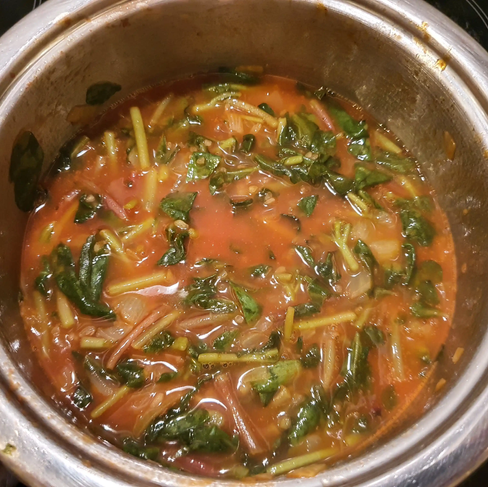Turkish Purslane Stew (Semizotu Yemeği)
- Sibel
- Oct 21, 2021
- 3 min read
This wholesome and comforting Purslane stew is made with a few simple ingredients are its ready in less than 30 minutes. Serve this stew with a dollop of vegan yogurt and some fresh, crusty bread for a nutritious and delicious meal.

This purslane strew sends me right back to your childhood. I’s a recipe my grandmother would often make, and although I wasn’t a huge fan of it as I child, I grew to love it and it’s now a dish I prepare often in my kitchen. This stew is my idea of the perfect fast food: it takes around 25 minutes or less to prepare and it’s made with simple, wholesome and healthy ingredients.

What is Purslane?
This leafy green is a staple vegetable in Turkish Cuisine, and it’s used in a variety of dishes. Purslane is actually a vegetable but it’s sometimes considered by some as a herb or a weed. The scientific name for the vegetable is Portulaca oleracea, but it has other amusing names such as Hogweed, Duckweed and Pusley, none of which sound that appetizing, so I’ll be sticking with Purslane throughout this post. This plant has thick, tender stems and succulent leaves. It has a mildly sweet and acidic flavour and it tastes similar to a combination of watercress and spinach. This vegetable can also be consumed raw so it can be prepared in a variety of cold dishes. Purslane is a very robust plant and it grows in a variety of environments; it can be found on sidewalks, damp soil or even in your garden, so it’s worth having a look before you go out to buy some.

Health Benefits of Purslane
This humble vegetable is loaded with a range of nutrients, including omega-3 fatty acids, making it a nutritional powerhouse. Purslane is low in calories and has a higher nutritional value than most other vegetables. It’s high in vitamin A and vitamin C, and minerals such as Magnesium, Iron, Potassium and Calcium. Purslane has the highest-recorded omega 3 fatty acids in any land plant, so even more reason to use this healthy vegetable in your cooking!
How to Serve Purslane Stew
Serve this stew warm with a dollop of vegan yogurt and some fresh crusty bread. It’s also delicious served on it’s own with a bit of lemon juice.

When is Purslane Season?
Purslane can tolerate drought and the heat of summer and it is in season from early summer through to the end of Autumn.
Where Can I Find Purslane?
You can find fresh purslane in most Turkish supermarkets, farmers markets or wholefoods stores. If you enjoy foraging for food, you can find wild purslane growing in areas with disturbed soil, it can also be found thriving in cracks and sidewalks, and if you’re lucky, you might even find wild purslane growing in your own garden.
Ingredients
Oil: For cooking: I like to use olive oil, but you can use vegan butter or vegetable oil instead.
Onion : I’ve used brown onions for this recipe.
Tomato Paste: the tomato paste will add an intense tomato flavour and will give the stew a rich colour.
Purslane – I’ve used fresh purslane, but frozen will work just as well.
Bulgur – there are lots of different types of bulgur, so make sure to use coarse bulgur for this recipe. For a gluten-free version, you can substitute the bulgur with rice.
Seasonings: Salt and pepper.
Vegetable stock: I’ve used a shop-bought vegetable stock cube for the recipe, but any kind of vegetable stock will do.
How to Make Purslane Stew
STEP 1:
Remove the thick stems and cut the purslane into small pieces. Thoroughly rinse the chopped purslane to get rid of any dirt. Add the olive oil and chopped onions to a large pot and sauté on a medium heat for about 5 minutes, until the onions start to soften.
STEP 2:
Add the tomato puree and cook for 1 more minute until in starts to release its aroma. Stir in the chopped purslane and bulgur.
STEP 3:
Pour in the vegetable stock, add the seasoning and leave it to gently simmer, on a medium heat, for about 10-15 minutes, or until the purslane has wilted. Serve hot with some fresh crusty bread.
Notes and Cooking Tips
Bulgur comes in different sizes: the main ones are fine bulgur and coarse bulgur. For this recipe you will need to use coarse bulgur.
You can adjust this recipe to suit your taste by adding different herbs and spices – a bit of chilli also goes really well in this stew.
Store the leftover stew in an airtight container and refrigerate for up to 3 days. To reheat, simply microwave or heat for a few minutes on the stove top.
For a gluten-free version, you can substitute the bulgur with rice or quinoa.















